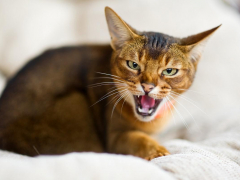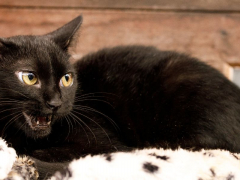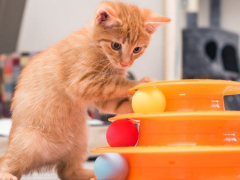
Cats can display quirky behaviors that often make no sense to us humans. If your cat likes to eat human hair from time to time, most likely yours, then you have found one of the stranger feline behaviors.
Although domestic cats and wild felines naturally exhibit allogrooming (mutual grooming), eating human hair may be associated with either a feeling of fondness and play behavior, or it may indicate stress, health problems, or behavioral issues.
Let us look at why your cat companion wants to eat your hair and what you can do to curb the behavior altogether.
7 Reasons Why Cats Eat Human Hair
When a cat eats human hair, (or bites, chews, or licks it), it is a natural exploratory behavior in kittens, but in adult cats, it can mean several things. Here are the most common reasons for this peculiar behavior:
1. Sign of Affection and Scent Marking
There’s nothing more adorable than a kitty who enjoys cuddling with its owner, followed by licking and biting the owner’s hair in return. In this case, hair-chomping is simply a form of allogrooming reserved for those identified as part of the same social group. As you stroke your cat’s fur coat, your cat may reciprocate the act of affection by licking or nipping at your locks.
When your cat rubs against your face, and licks and nibbles on your hair, they are scent marking you to ensure you that smell familiar; after all, cats are smell driven. If you praise your cat with extra love and petting, your cat will most likely repeat the same behavior as a form of reinforcement.
2. Scented Hair Products
Some cats may find scented hair products incredibly tempting and appealing. If you have newly washed hair, your locks undoubtedly carry the scent of your shampoo and conditioner. Your cat may sample the enticing smell with a lick and continue to nibble your hair if she likes the flavor of your hair products (especially ones that are fruity or floral).
3. Attention-Seeking Behavior
Cats are smart and know how to attract our attention. While some meow excessively, others will knock things over in the hope that they get what they want. My cat will usually rub against me. Undeniably, attacking your hair and eating it will guarantee that you stop whatever you’re doing and give your cat your full and undivided attention.
Try to not reinforce attention-seeking behavior by reacting to it, which might lead to a behavioral problem in your cat. The more you react, the more likely your cat will repeat the unwanted behavior, even if your reaction is negative. Redirecting your cat to another activity is a better idea. More on that in a moment.
4. Human Hair Resembles a Toy
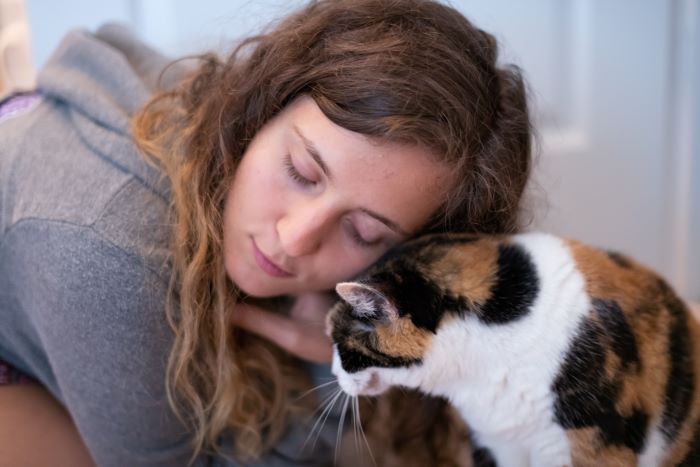
Dangling hair is just another cat toy, as far as your cat is concerned.
What do human locks of hair and cat toys have in common? They resemble wiggly strings!
For most kittens and junior cats, long hair is an irresistible-looking toy. Not only does your hair smell great, but it looks like a dangling teaser. No young (or young-hearted) cat can resist swatting, batting, attacking, or biting a luscious crown full of tresses; after all, the feline has evolved to be an excellent hunter through attraction to movement. Most cats will grow out of misdirected predatory behavior if you redirect your cat’s attention to inanimate objects when he is a kitten.
5. Early Weaning
Evidence suggests that early weaning can influence a cat’s ability to manage frustration, aggression, anxiety, and stereotypic behavior like wool suckling and hair chewing.
Kittens need to remain with their mothers until eight weeks, but twelve weeks is even better from a developmental and behavioral viewpoint. When a cat feels compelled to eat human hair, may signify that your cat was separated from her mother or weaned too early as a kitten.
6. Pica – An Unusual Eating Disorder
Pica is an unusual eating disorder that includes ingestion of non-food items. A cat exhibiting Pica may chew on a wide range of non-edible materials including hair, by repeatedly grinding the chosen piece with the back teeth before swallowing it.
Pica, similar to wool-sucking, may also be linked to early weaning or triggered by anxiety and stress, nutritional deficiencies, or a medical cause.
Pica can be serious since it can result in potential poisoning or gastrointestinal obstruction. It’s advisable to seek veterinary advice if your cat insists on repetitive hair chewing.
7. Stress

Hair chewing can be a sign of stress in your cat.
Many indoor cats are susceptible to stress since they live in a limited environment with fewer opportunities to do what comes naturally to them, such as exploring and hunting.
Similarly, any change in the usual routine, like the addition of a new pet or a house move, may induce anxiety, causing a cat to overgroom either their body or “overgroom” you, by eating your hair. This is because grooming behavior isn’t only a feline maintenance activity but is also a coping mechanism that helps lower overstimulation and deflects aggression away from other cats.
Also Read: 5 Visual Signs Of A Stressed Cat And How To Help
Is It Bad for a Cat To Eat Hair?
Although human hair is non-toxic for cats, hair fibers consist of high amounts of sulfur, structural lipids, and keratin proteins that cats can’t absorb. Hair ingestion over an extended period can cause gastric irritation and vomiting.
If a cat eats human hair, it can also form larger hairballs than fur consumption. In the best cases, the hairball will pass through the digestive system or it will be vomited. However, if the hairball is too large and can’t be expelled, it can cause serious health problems, including intestinal blockage.
Symptoms of intestinal blockage in felines include:
- Frequent vomiting
- Abdominal pain
- Reduced appetite or food refusal
- Lack of energy
- Diarrhea or constipation with bloody stools
- Salivation
- Litter box straining
- Hiding and reluctance to interact
- Out-of-character behavior or aggression
If you suspect a partial or complete intestinal blockage, take your cat to the emergency vet immediately since an abdominal obstruction is a life-threatening condition that may require surgical intervention in severe cases.
Keep in mind that some hair sprays, mousses, and hair dyes contain toxic ingredients for cats. Minoxidil is a popular medication found in several hair-growth products. Ingestion through skin licking or hair biting can cause intoxication, vomiting, illness, and death, so please keep haircare products away from your cat and don’t let your cat eat your hair.
How Do You Stop a Cat From Eating Hair?
It is best to determine the root cause of why your cat feels compelled to eat human hair before you take a stab at changing the behavior.
If your cat companion compulsively chews on your hair during stressful or monotonous times, help your cat to de-stress through gentle coat brushing and a relaxing cat massage. Plug in a Feliway diffuser and try to reduce environmental stress.
Consider using feline facial pheromone products around the house. You can also minimize the addition of new people, pets, and scents from your home and keep the environment relaxing and safe-feeling for your cat.
If you suspect your cat’s hair eating is due to boredom or the impulse to teeth-grind, then redirect your cat’s attention to chew on something harmless, such as Matabi sticks or cat grass. If the hair chewing comes from misdirected predatory behavior, then engage your cat in play with their favorite toy.
Food foraging through puzzle feeders is an alternative activity that stimulates a cat’s body and mind, reducing the impulse to chew on and eat your hair.
For a cat that can’t resist a floral-scented shampoo/conditioner, consider replacing your existing hair products with unscented ones, or ones with a citrus scent, as cats naturally dislike the smell of citrus.
Ideally, distract your cat before he starts chewing on your hair. Do not reinforce the behavior by providing any attention when he does do it.
If nothing seems to work, move away from your cat when she attempts to eat your hair, even if it means making a yelping or “ouch” noise and then leaving the room. Be consistent and persistent in this approach, and it should yield positive positive results after a couple of weeks.
How To Reciprocate Your Cat’s Affection
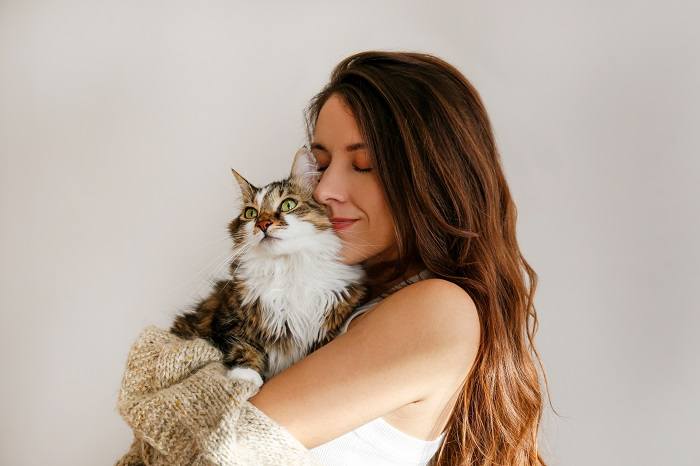
Engage in healthy and positive acts of affection with your cat.
There are several ways that you can reciprocate your cat’s affection in healthy and positive ways. For instance, you can show your cat how much you love her with slow eye blinking.
Since grooming is essential to a cat’s self-care and self-soothing, invest in a good-quality comb or slick brush. Brush your cat weekly to keep the coat mat-free and reduce hairballs. Allow your cat to rub your face and lick your hand in return as long as it’s enjoyable for you both.
Depending on what your cat enjoys, spend some time appreciating each other’s company, either by cuddling, listening to soothing music, or going for a harness and leash walk.
You can also introduce your cat to clicker training to decrease boredom and minimize anxiety, all while participating in fun activities. Training cats offers physical and mental stimulation while reinforcing the human-animal bond with enhanced trust and confidence.
Final Thoughts
Although allogrooming is a typical behavior exhibited by cats to reciprocate a strong connection and interchange scents, excessive chewing on human hair can lead to hairballs and gastrointestinal blockages. Some hair products may also be unhealthy for cats to ingest by chewing your hair.
The best way to deal with your cat’s hair chewing is to redirect your cat’s attention to an enjoyable activity or a fun game. Don’t give your cat the opportunity to chew on your hair. By being consistent in your approach, your cat will eventually abandon this behavior, which is really the most healthy approach.
Also Read: How To Safely Play With A Cat, According To A Cat Behaviorist
Frequently Asked Questions
How do I get my cat to stop eating my hair?
Find out what motivates your cat to eat your hair, whether it’s health or behavior related. Redirect your cat to an exciting, stimulating activity away from your scalp and enrich the cat’s indoor environment.
If they persist, make a yelping or ouch noise to deter them and leave the room. If your cat displays obsessive-compulsive human hair overgrooming and biting, consult a veterinarian or an animal behaviorist.
Why does my cat bite and pull my hair?
Latching onto and attacking long human hair may be fun predatory play for a kitten or junior cat. Most cat owners prefer a cat to focus on a dangly toy.

